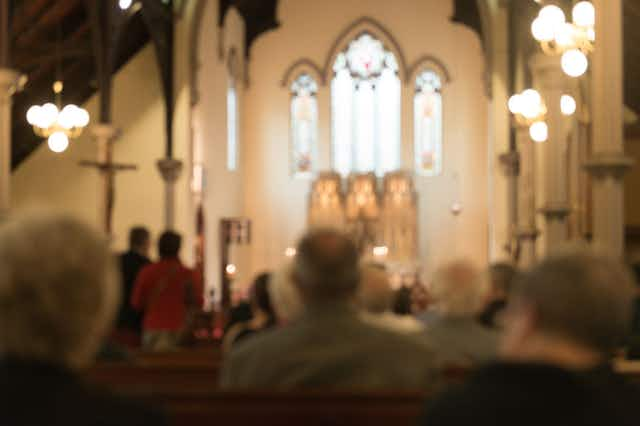Greek Orthodox Funerals: Traditions & Etiquette
Updated
Published

Erin Coriell, BA in Mass Communication/Media Studies
End-of-life care educator and grief worker

Cake values integrity and transparency. We follow a strict editorial process to provide you with the best content possible. We also may earn commission from purchases made through affiliate links. As an Amazon Associate, we earn from qualifying purchases. Learn more in our affiliate disclosure.
Greek Orthodox Church members take comfort that death isn’t the end and life is everlasting. The Greek Orthodox Church believes that in life after death, the soul is reunited with the body and with Christ — and a deceased person hasn’t just died, he’s “fallen asleep.”
Strong faith and a solid community base — it’s what you can expect to encounter when someone in the Greek Orthodox Church has died. You’ll also get support and space to grieve. Death is a sacred time and an opportunity for spiritual reflection. It’s also a time to express emotions and offer praise while you grieve.
Vitual funeral tip: If you're planning a virtual Greek-Orthodox funeral using a service like GatheringUs, you can still take part in many of the rituals below. Talk with your funeral director or event planner to help adapt the customs.
Jump ahead to these sections:
- Greek Orthodox Pre-Service Rituals
- Funeral Service and Traditions
- Greek Orthodox Church’s Views on Grief, Mourning Periods, and Remembering the Dead
- Greek Orthodox Funerals: FAQ
Greek Orthodox Pre-Service Rituals

When someone in the church has died, the family will:
- Notify the priest of the local parish and a funeral home.
- Coordinate all prayer service and funeral details with the priest.
- Communicate its wishes to the funeral home once the details are set.
- Write the obituary once the funeral home and church have agreed on a date.
The family will help prepare the body in Eastern Orthodox practices. In other words, family members bathe and clothe the body immediately after death. This is often done with a priest present. The priest will bless the casket with holy water once the body is in the casket. Modern-day Orthodox families may opt to have the funeral home prepare the body for the wake.
Once the body has been prepared, a priest will lead a prayer service called the Panikhida. This marks the beginning of a three-day wake. During the wake, the Book of Psalms is recited by family and friends.
Share your wishes, just in case.
Send your end-of-life preferences—including your cremation, burial, and funeral choices—with your loved ones. Create a free Cake profile to get started.
Trisagion service
A Trisagion is a prayer service performed by a priest and it happens immediately following the death or on the night before the funeral. A Trisagion may also occur at the gravesite after the service and on memorial days set by the church.
The prayers are lead by a priest in a call-and-response format. The family members and the church community attend. The first Trisagion can take place in the home of the deceased or at the funeral home. One of the lines recited is, "Holy God, holy and mighty, holy immortal one, have mercy upon us." The Trisagion is a request for mercy for the deceased and for everyone who is still living.
Preparing for the funeral
The services usually include a wake and funeral mass in a church. Like many conservative Christian religions, cremation is not allowed. The Greek Orthodox Church believes in the resurrection of the body and views cremation as a sin. The family members recite readings and they may also serve as pallbearers. The priest is the only one allowed to recite prayers in church and give the eulogy.
Funeral Service and Traditions
The funeral service and traditions follow a specific order, outlined below.
Tip: No matter what a family's culture and traditions are, funeral planning is hard. So are the many other tasks you might face after the death of a loved one. If you'd like some help and guidance through the process, check out our post-loss checklist.
Order of service
The most common order of the funeral process is Trisagion, wake, church service, and burial. The order of the service includes a Trisagion, readings, and anointing. There is also a blessing where the priest recites, "Blessed are you, O Lord, teach me your statutes!" (Psalm 119:12). The priest will often close with a Trisagion before the casket closes.
Popular hymns and songs
The Orthodox service does not place much emphasis on funeral music. Some services may have hymns lead by a choir or the priest. The Trisagion might be sung at the closing of the church service.
Greek funeral flowers
Flowers are present on many occasions. White flowers of various kinds are common for funeral services. The color white represents mourning and white lilies represent peace. Church members and friends often send plants and bouquets in memory of the deceased.
Flowers are often passed out during the prayer service at the gravesite. At the conclusion of the service, each person usually bows and places his or her flower on the casket.
Other rituals and customs
Only the priest has permission to speak inside the church during the funeral service. Unless the family makes a special request, the casket will remain open in church. This allows for everyone in the congregation to say his or her final goodbye to the body.
Etiquette
Attendees dress in dark, modest clothing. Men wear dress suits with a tie and women wear dresses. The church encourages men and women to cover their arms and legs.
Greeting the family at an Orthodox funeral is very important. It is a tradition in this religion to offer condolences and prayers. The best time to greet the family is after the burial service or at the luncheon that follows the burial. The formal name of the luncheon is Makaria and fish is usually served.
People approach the casket to say their final goodbyes at the end of the church service. It’s common to bow and kiss the cross or object on the casket.
The congregation stands for the service whether pews are present. This applies to everyone except the elderly and people who have difficulty standing.
Greek Orthodox Church’s Views on Grief, Mourning Periods, and Remembering the Dead

The immediate family usually takes the week after the funeral off work and family members welcome people into their homes for a short visit. Vigil candles and incense are lit to signify the presence of their loved one, and it’s a time for reflection and prayer.
Commemoration services usually take place a week following the funeral. This service is almost identical to the funeral service — without the casket present. The funeral readings and psalms read at the funeral and Trisagion are also in this service. There are several Commemoration services after someone dies. These memorial services occur one week, 40 days, and one year after the death. Some families and church communities also host annual memorials in the person's honor.
The first commemoration that takes place is a gratitude service. Attendees state their gratitude to God for granting eternal life to the deceased. This service exhibits their belief in the continuation of life after death.
During the second, 40-day memorial, families will usually gather at the church, gravesite, or a family member's home. This is a time to gather and let go of grief as a community. Even though their religion believes in an afterlife, they recognize grief and the need to process it. The grief doesn't go away after the 40th day but it brings a sense of peace because it keeps the memories and stories alive.
The 40-day memorial serves as an active grief process. The community shares stories and expresses its grief and praises out loud. This is a notable way to celebrate life and turn toward grief instead of dismissing it. They make space for grief, which in turn brings healing.
Greek Orthodox Funerals: FAQ
Greek Orthodox funerals can be more formal and structured than other religious practices. It’s helpful to ask questions before attending so that you can be prepared and respectful.
Q: What should you say to grieving family members at a Greek Orthodox funeral?
Many people will say “May you have an abundant life,” “Memory eternal,” or “May his or her memory be eternal.” If you are not Greek Orthodox and don't feel comfortable saying these things, that's okay. You might consider saying "May his/her memory live on. I will be thinking of you during your time of grief."
Q: How long does the funeral usually last?
A bit longer than the average funeral length, A Greek Orthodox funeral service is about 90 minutes long. The church ceremony is about one hour and the burial is about 30 minutes. A luncheon is optional and lasts around one to three hours.
Q: How much should you donate to the priest or church that hosted the funeral?
It’s up to the family, but if there is a memorial fund, it will be listed in the obituary. Donations go straight to the Greek Orthodox church. The standard donation amount is $25 – $50. Some families may give more if they are members of the church.
Q: Should I approach the open casket?
Yes, you are welcome to say your final goodbye to the deceased. If you belong to a different religious faith, it’s not required. Seeing the physical body for the last time can provide closure — but it’s up to you whether you approach the casket.
Traditions to Last a Lifetime
Greek Orthodox traditions are extremely intentional because death is a sacred passage. Death is approached with fearlessness and strong faith — and loved ones are memorialized even years after death.
Sources
- The Trisagion Service for the Departed, Greek Orthodox Archdiocese of Australia, www.greekorthodox.org.au/
- A Guide to an Orthodox Funeral, Saints Sergius and Herman of Valaam Monastery, ss-sergius-herman-valaam.org/funeral
- Funerals, Annunciation NYC, www.annunciation-nyc.org/our-parish/sacraments/funerals
- Funerals, Transfiguration Greek Orthodox Church, transfiguration.org/resources/religious-links/



